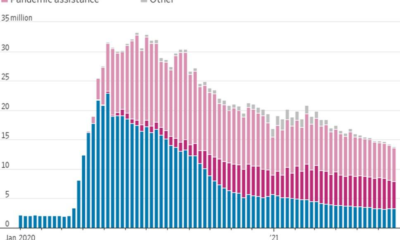Money
After hate-motivated attack, Scott Jones’ play chronicles forgiveness with two actors, a children’s choir and the music of Sigur Ros

decided to forgive the man who stabbed him in a homophobic attack, leaving him a paraplegic. Struck by the story, Jillian Keiley, who was artistic director of the NAC’s English Theatre department at the time, embarked on the long process of assembling a creative team to bring it to the stage. Under her direction, it premiered in St. John’s, NL last summer and opens at the NAC this week, with a children’s choir, the music of Sigur Ros and Jones himself part of the production. In this interview, Keiley talks about the significance of the children’s choir and the music, and the complexity of forgiveness.
A: I was at the NAC one day, flicking through my phone and this article came up: ‘New Glasgow man forgives his attacker.’ Honest to God, it was like somebody hit me with a frying pan. I stopped in the middle of the corridor and I wept. It was like being struck by lightning. That was 2014. I was just shook by this story and it never went away from me. It was always in my craw. Seriously. I thought, I’d love to pursue that guy in Nova Scotia who forgave his attacker.
Q: Was a challenge to find him and get his blessing?
A: A friend told me that another friend knew him really well so I reached out to him and said I really feel like we should have a play about this. We met for supper, and it was like being on a date and I was trying to sell my wares so he would like me enough to trust me with his story. Then another year passed and I sold (playwright/co-creator) Robert Chafe on the idea of doing it. Everything fell into place but it took five years.
Advertisement 4
STORY CONTINUES BELOW
This advertisement has not loaded yet, but your article continues below.
Article content
Scott Jones, Jillian Keiley and the show’s children’s choir at a weekend Rehearsal for I Forgive You.
Scott Jones, Jillian Keiley and the show’s children’s choir at a weekend Rehearsal for I Forgive You. PHOTO BY ASHLEY FRASER /Postmedia
Q: Scott co-created and is part of the show, too. What’s his role?
A: He’s not an actor and he never wanted to be an actor. The whole thing for Scott is that he wants to be honest. He thinks that so much about forgiveness is about being honest with yourself and being honest with your community. There is one moment in the show where Scott speaks directly to the audience and we don’t know what he’s going to say. But in terms of his role, there’s a choir of children and Scott is actually, for most of the show, conducting the children so you don’t actually see his face. You see his back.
Q: Tell me about the choir.
A: We did a huge audition call here in Ottawa and we saw a lot of kids, from about age 11 to 16 or 17. It’s an astounding choir and the music is absolutely beautiful. It’s by Sigur Ros. We had Ingi Garðar Erlendsson, the orchestrator for Sigur Ros, come over from Iceland to work with us to create a score for children’s voices. It’s chilling and extraordinarily beautiful.
Advertisement 5
STORY CONTINUES BELOW
This advertisement has not loaded yet, but your article continues below.
Article content
OTTAWA: A local children’s choir was rehearsing for the play, I Forgive You, that’s opening next week at the National Arts Centre.
OTTAWA: A local children’s choir was rehearsing for the play, I Forgive You, that’s opening next week at the National Arts Centre. PHOTO BY ASHLEY FRASER /Postmedia
Q: Why Sigur Ros?
A: Because when Scott was in the hospital eight or nine years ago, the only thing that would calm him was listening to Sigur Ros on his headphones. When no language, no hugs, no tears could comfort him, he listened to the most soothing, beautiful music in the world, which was Sigur Ros. It was complex to get permission because they’re so famous and important but they loved Scott’s story and they were very happy to allow us the licence to use the music.
Q: The choir is made up of young people, but the show is not recommended for children under 16. Why is that?
A: We are really careful about that because we do describe the attack and we are aware that because of the reality of Scott being right there, it might trigger some people who have experienced violence. There’s not a lot of shouting or violence, but the tension is that the guy is right there, and there are children right there. What we’re wrestling with is the story of what kind of child grows up to be somebody who could really hurt another person, and what kind of child grows up to be the person who is so big of heart that they could actually forgive somebody. So the children are not just there for the soundscape, they are really the point in a lot of ways.
Q: It stars Nathan Carroll and Jeff Ho, two musically inclined actors. What were you looking for in the casting?
A: Casting it was an incredible journey because we had to find exactly the right talent. These two guys have to be the right age, both gay, and both really good pianists. They have to be comfortable working with kids and verbatim text, and have the emotional depth. These two are incredible. They both play Scott but one of them plays the part of Scott that is angry and has trouble forgiving. The other one plays the version of Scott that wants to forgive and help the person who did the damage because that’s better for the world.
Q: What do you hope audiences will take away from it?
A: I hope that they see opportunities to forgive people, and also to forgive themselves if they don’t. It’s a very grey area, but I think if you leave the show with some softening in your soul about who we forgive and who we don’t, and why, I think there’s so much to that. If you understand the burden the person is carrying, that helps you see how you could or could not forgive. But it’s also understanding that there are times when you can’t forgive somebody, and I think that’s what I love so much about this piece – the humanity. Some days it’s really hard to forgive.
Money
Where Tech Talent Goes To Thrive

here is a worldwide shortage of digital skills. In a world increasingly reliant on technology, demand for technological skillsets is rising by as much as 50%. Meanwhile, nearly three-quarters of today’s workers don’t feel equipped to learn the digital skills needed by businesses.
The most acute shortage is in advanced skills like programming, especially for new technologies like AI and blockchain.
This demand gives skilled tech workers, entrepreneurs, and leaders the pick of where to base themselves. As cities and nations compete to attract tech talent, what makes these prized individuals choose one place over another?.
Initial Attraction
In a survey of ‘tech migrants’, Boston Consulting Group identified a mixture of short-, medium-, and long-term levers businesses and cities could use to attract talent.
The initial attraction is often brute economics: higher pay and lower taxes. That’s certainly what brings people to Dubai, says Vladimir Vrzhovski, Tech and Digital Lead at Mercer: “Dubai pays about 30% higher than most of the mature tech hubs around Europe and Asia.” It also has a lower cost of living, especially when its 0% income tax is taken into account.
Businesses operating in the city’s free zones – like the tech-focused Dubai Internet City (DIC) and Dubai International Finance Centre (DIFC) Innovation Hub – also benefit from 0% corporation tax. BCG credits the incentive with bringing big names like Amazon, Google, and Oracle to the emirate.
It is an echo of London’s rise to tech prominence, offering tax relief on tech investments via its Seed Enterprise Investment Scheme (SEIS) to funnel the city’s vast pools of finance towards digital businesses.
The presence of blue-chip names affords another major draw for tech talent: opportunities.
Money
Adding exercise into treatment may reduce substance use, study shows

One key to fighting addiction may be exercise, according to a new study.
Researchers undertook a review of the existing literature around physical activity and its relationship to substance use, and they found that regular exercise was associated with lowered use in about 75% of the studies investigating that question, according to the analysis.
The review, published Wednesday in the journal PLOS ONE, looked at 43 studies with more than 3,000 total participants. In addition to a reduction or cessation in substance use, the studies also found improved markers of physical health and decreased depressive symptoms, the study said.
“People think that during treatment people should only do psychotherapeutic treatments … but that’s not what we’ve seen in our study,” said lead study author Florence Piché, a doctoral student and researcher at Université de Montréal in Canada. “It’s very beneficial to do physical activity in addition to the treatments.”
There are limitations to the findings. The review found that most of the studies the researchers examined had a high risk of bias, meaning more research is needed to confirm their findings, said Dr. Aaron Kandola, research fellow at Medical Research Council Unit for Lifelong Health and Ageing at University College London.
The studies were also not directly comparable enough to build a comprehensive and generalizable understanding of the relationship, Kandola said in an email. Kandola was not part of the research.
However, the findings were still significant and useful, he added.
“Substance use disorders are a major public health problem lacking low-cost, evidence-based solutions,” he said, adding that substance use disorders are worsening in many high-income countries — including the United States.
Finding more accessible solutions to this disorder is especially important because it often occurs with other mental health problems such as depression and anxiety, which disproportionately affect people with fewer socioeconomic resources and areas with higher deprivation, he said.
Physical activity may be a useful and accessible part of a treatment plan for substance use disorder, said Dr. Mark Smith, professor of psychology at Davidson College in North Carolina. Smith was not part of the research.
“I think there’s now a sufficient amount of data to indicate that various forms of physical activity and exercise are generally effective at reducing substance use in individuals seeking treatment,” he said.
What exercise does
Most people can benefit from engaging in physical activity, Kandola said.
One benefit the studies found is improvements in physical health such as cardiovascular endurance or muscle strength, Smith said. And although that may not be the primary goal of the research, he said this finding is important because it shows the physical activity is doing its job to promote physical health.
Money
Blood sugar drug tirzepatide also leads to substantial weight loss in diabetes patients, Eli Lilly says

There’s more evidence that the injectable drug tirzepatide helps people with diabetes lose weight as well as control their blood sugar, according to the drug’s manufacturer, Eli Lilly and Company.
In a new study, more than 900 adults with obesity and diabetes took the drug for a year and five months, and those on the highest dose lost an average of 34 pounds, or nearly 16% of their starting weight. It also helped people reduce their blood sugar, the company said in a news release. The data has not yet been peer-reviewed or published in a medical journal.
“We have not hit 15% in any other phase three trial for weight management in this type two diabetes population,” said Dr. Nadia Ahmad, an associate vice president at Eli Lilly and medical director of obesity clinical development for the company.
Ahmad said the company was pleased with these results, given how hard it is for people with type 2 diabetes to lose weight.
Tirzepatide is currently sold as Mounjaro and approved to help people with type 2 diabetes control their blood sugar.
Lilly says it will use the new study, along with results from an earlier study of weight loss in people without diabetes, to ask the US Food and Drug Administration to fast-track approval for tirzepatide purely for weight loss, which would make it a direct competitor to the blockbuster obesity drug Wegovy.
Plenty of people aren’t waiting for the FDA’s nod.
“I am aware of and I’ve heard, you know, it being sort of used off label for weight loss and individuals who do not have diabetes,” said Dr. Kimberly Gudzune, medical director of the American Board of Obesity Medicine. Gudzune was not involved in the tirzepatide study.
Gudzune points out that once a drug is FDA approved it can be prescribed for any reason a doctor sees as medically necessary.
Tirzepatide, along with several similar types of drugs taken for diabetes, went into shortage last year as success stories posted on social media fueled runaway demand for their weight loss benefits. The shortages made the medications difficult for patients with diabetes to get.
Tirzepatide works by mimicking the action of two different gut hormones. When blood sugar rises after eating, the drug stimulates the body to produce more insulin, which lowers blood sugar. It also slows down the movement of food from the stomach, making people feel fuller for longer. In clinical trials, people who took tirzepatide experienced more nausea, vomiting and diarrhea compared with those who took a placebo injection.
Semaglutide, manufactured by Novo Nordisk, has also been approved as a weight loss medication for overweight adults with at least one associated health problem since 2021. When prescribed for weight loss, it is sold under the brand name Wegovy. When prescribed for diabetes, the injection is sold under the brand name Ozempic.
High demand, coupled with manufacturing problems, threw Wegovy into shortage for much of the last year. That shortage then rippled into shortages for diabetes patients as doctors began prescribing other diabetes medications off-label for weight loss.
There has already been a lot of buzz about tirzepatide’s potential as an obesity medication. In a clinical trial published in the New England Journal of Medicine last year, people who were overweight or obese, but did not have diabetes, lost an average of 52 pounds on the highest dose of the drug, or more than 20% of their starting weight.
“In the last year has been really exciting just to have more tools in the toolbox, so to speak. And tools that, you know, we’re seeing really achieving outcomes that patients for the longest time have been hoping to achieve,” Gudzune said.
If those results hold up in the real world, that would make it the most potent of the injectable weight loss medications.
Indeed, this week Lilly aims to begin a study that will test Mounjaro against Wegovy head-to-head in 700 participants at 61 sites in the United States and Canada, according to clinicaltrials.gov. The study will conclude in February 2025.
-

 Business3 years ago
Business3 years agoHyundai Leads Industry in U.S. News & World Report 2023 Best Cars for the Money Awards
-

 Innovation3 years ago
Innovation3 years agoJay-S ventures into the urban genre with “Bailar en la Playa” his latest production
-

 Business3 years ago
Business3 years agoThree Questions Small Business Owners Should Ask In Creating A Workplace Culture – Forbes
-

 Business3 years ago
Business3 years agoA Fintech Makes It Easy For Small Businesses To Offer 401(k) Retirement Benefits – Forbes
-

 Business3 years ago
Business3 years agoBritain’s Small Businesses See Better Times Ahead But Is Their Optimism Justified? – Forbes
-

 Money3 years ago
Money3 years agoCharlie Crist leads Democratic gubernatorial field again in money chase – Florida Politics
-

 Money3 years ago
Money3 years agoTesting New Tools for Horizon Worlds Creators To Earn Money
-

 Business3 years ago
Business3 years agoSmall Business Labor Shortage – Forbes
